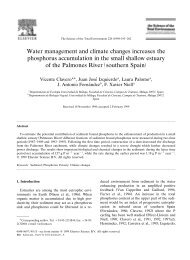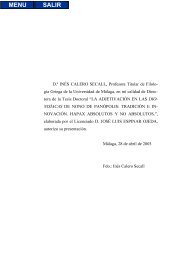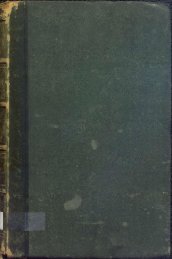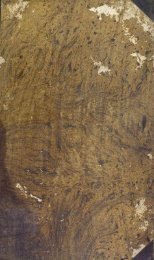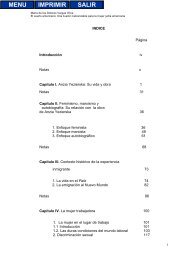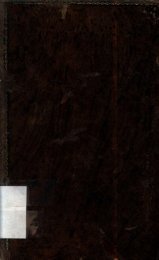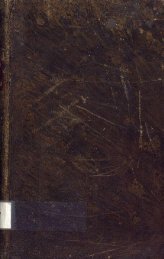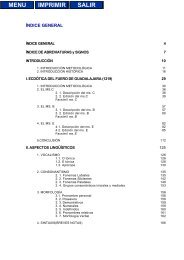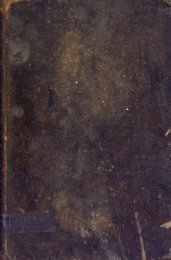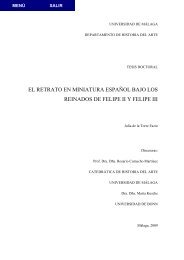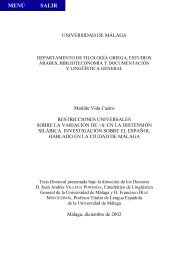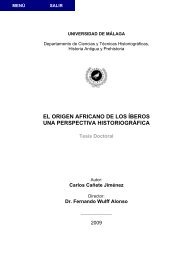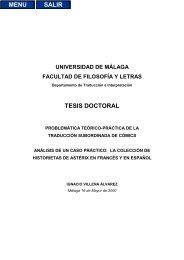- Page 1:
UNIVERSIDAD DE MÁLAGA Tesis doctor
- Page 5:
AGRADECIMIENTOS Deseo iniciar estas
- Page 8 and 9:
10.- La entrega del hospital Real d
- Page 10 and 11:
(1695/1721) . . . . . . . . .379 1.
- Page 12 and 13:
8.- Presentación de las Constituci
- Page 14 and 15:
6.2.- Arrendamiento de casas . . .
- Page 16 and 17:
5.2.- Jubileo de las XL Horas . . .
- Page 18 and 19:
5.6.- Pía Asociación de la Visita
- Page 20 and 21:
1.1.6.- Reorganización . . . . 121
- Page 22 and 23:
San Julián . . . . . . . . 1328 3.
- Page 24 and 25:
CAPÍTULO XXXII: GRÁFICOS DE HERMA
- Page 26 and 27:
ABREVIATURAS aa.cc. actas capitular
- Page 29 and 30:
“Son de San Julián y es un tema
- Page 31 and 32:
acervo documental, principalmente e
- Page 33 and 34:
Ante esta situación, se ha hecho o
- Page 35 and 36:
agradecimiento de los miembros de l
- Page 37 and 38:
documental complementario, un cuadr
- Page 39:
PARTE I SIGLOS XV/XVII LA PRIMITIVA
- Page 43 and 44:
1.- ANTECEDENTES HISTÓRICOS DE LOS
- Page 45 and 46:
no cumplían con los requisitos pro
- Page 47 and 48:
noticiable dio origen a que el hosp
- Page 49 and 50:
San Giles para el cuidado de cuaren
- Page 51 and 52:
2.- LA FUNDACIÓN DE LA HERMANDAD Y
- Page 53 and 54:
posteriores Reglas de la Hermandad
- Page 55 and 56:
vecinos. Efectuado el recuento gene
- Page 57 and 58:
hospital de la ciudad con la denomi
- Page 59 and 60:
América y que “se habian desarro
- Page 61 and 62:
hay que prestar especial atención
- Page 63 and 64:
dignidad de prior, unida a la canon
- Page 65 and 66:
comienzo ni tampoco la de su culmin
- Page 67 and 68:
Al poco tiempo de estar el hospital
- Page 69 and 70:
aposento del agua, por un período
- Page 71 and 72:
obligado el Capellan de celebrar de
- Page 73 and 74:
El emperador Carlos ratificaba, por
- Page 75 and 76:
Santo Espíritu recibió donativos
- Page 77 and 78:
(...) y estando presentes (...) Alo
- Page 79 and 80:
de 1.500 maravedíes de tributo sob
- Page 81 and 82:
aunque más adelante este beneficio
- Page 83 and 84:
deseo en 1543, ante el escribano p
- Page 85 and 86:
correspondiente a una viña. El res
- Page 87 and 88:
INGRESO HERMANO Ídem Gonzalo de Fu
- Page 89 and 90:
INGRESO HERMANO Ídem (¿?) García
- Page 91:
CAPÍTULO III: LA HERMANDAD DE LA C
- Page 94 and 95:
los trabajos de la Catedral que se
- Page 96 and 97:
musical por el maestro Esteban Brit
- Page 98 and 99:
Hermandad de la Caridad, a la cual
- Page 100 and 101:
Tres años después, el también es
- Page 102 and 103:
AÑO IGLESIA HOSPITAL CARIDAD TOTAL
- Page 104 and 105:
AÑO IGLESIA HOSPITAL CARIDAD TOTAL
- Page 106 and 107:
Finalmente, en este tercer y últim
- Page 108 and 109:
urbe. Otros dos acuerdos adoptados
- Page 110 and 111:
Con respecto al número de muertos,
- Page 112 and 113:
6.- EL CULTO A SAN JULIÁN Antes de
- Page 114 and 115:
Conversaciones Históricas Malague
- Page 116 and 117:
Ilustración 15: Lienzo de San Juli
- Page 118 and 119:
Al año siguiente, la Iglesia Cated
- Page 120 and 121:
7.- INTERVENCIÓN DE FELIPE IV EN E
- Page 122 and 123:
de proseguir en esta forma= Mando q
- Page 124 and 125:
“Hermanos Mayores”, comprendido
- Page 126 and 127:
Que asistan por sus personas aver h
- Page 128 and 129:
la mañana al medio dia y a la noch
- Page 130 and 131:
al cozinero á de havisar al mayord
- Page 132 and 133:
mayordomo de Casa, en conciencia y
- Page 134 and 135:
vulnerables al contagio. A medida q
- Page 136 and 137:
contagio, que entonces padecia esta
- Page 138 and 139:
En cuanto a la efigie del Santo Cri
- Page 140 and 141:
Santa Ana, desocupado por entonces,
- Page 142 and 143:
en el hospital de la Cruz Verde. A
- Page 144 and 145:
ayuda a los enfermos, la concesión
- Page 146 and 147:
que fuere mi real voluntad. Con cal
- Page 148 and 149:
Jerónimo de Pisa Veintimilla, pret
- Page 150 and 151:
Cofradía una capilla 138 . Así pu
- Page 152 and 153:
Llama poderosamente nuestra atenci
- Page 154 and 155:
12.- LA HERMANDAD DE LA CARIDAD ENT
- Page 156 and 157:
presentes acordaron que la talla do
- Page 158 and 159:
13.- INSCRIPCIÓN DE HERMANOS La in
- Page 160 and 161:
INGRESO HERMANO Ídem Lorenzo Fern
- Page 162 and 163:
-RECAPITULACIÓN La Hermandad de la
- Page 165:
PARTE II DÉCADAS FINALES DEL SIGLO
- Page 169 and 170:
1.- ANTECEDENTES Y APROBACIÓN DE S
- Page 171 and 172:
En el primero de ellos, aparecía u
- Page 173 and 174:
Los alcaldes (uno antiguo y otro mo
- Page 175 and 176:
las ha de ir regulando como fueren
- Page 177 and 178:
24 Ibídem, fols. 26-28. Santo Chri
- Page 179 and 180:
Los diputados de entierros tenían
- Page 181 and 182:
Hermandad y el pago de luminaria qu
- Page 183 and 184:
“Todos los dias de Fiesta es cost
- Page 185 and 186:
de Valdivia 47 , designando al raci
- Page 187 and 188:
Desde la tienda de campaña del Rey
- Page 189 and 190:
Sánchez Garcés, padres de Elvira
- Page 191 and 192:
Ana de Marallén, el parentesco esp
- Page 193 and 194:
enturbió los planes de su padre en
- Page 195 and 196:
Tras cumplir el período obligatori
- Page 197 and 198:
sierra, y su esposa, Ana de Castril
- Page 199 and 200:
Estas y otras preguntas no podemos
- Page 201 and 202:
tener enteramente pagado (...) la r
- Page 203 and 204:
estudios, dado que nos acercan a la
- Page 205 and 206:
posesiones y hacienda, que comprend
- Page 207 and 208:
después, como prebendado de la Cat
- Page 209 and 210:
Alonso García Garcés compró, en
- Page 211 and 212:
Andrés Camparo, proveedor general
- Page 213 and 214:
continuara los adornos de dicha cap
- Page 215 and 216:
La iglesia del Císter mandada a ed
- Page 217 and 218:
caídas, ojos profundos con un velo
- Page 219 and 220:
Ilustración 22: Retrato de Alonso
- Page 221 and 222:
llamar al escribano Vargas Machuca,
- Page 223 and 224:
casa, y hospicio de la Santa Charid
- Page 225 and 226:
esto de ciudades, villas y lugares
- Page 227 and 228:
“(...) detras del altar mayor de
- Page 229 and 230:
obras comenzaron en el año 1514 y
- Page 231 and 232:
“(...) para que ya que no tengan
- Page 233 and 234:
en dando la Oración les a de ençe
- Page 235 and 236:
Al día siguiente, se expedía un c
- Page 237 and 238:
espuesta a ese escrito. La carta -f
- Page 239 and 240:
En el resto de la documentación ep
- Page 241 and 242:
de cabildos de ésta, en la que Mig
- Page 243 and 244:
Esta leyenda se añadió en el año
- Page 245:
tapadera, realizado en madera polic
- Page 249 and 250:
1.- Acuerdo para el hermanamiento U
- Page 251 and 252:
nuestra ciudad, la Junta de Gobiern
- Page 253 and 254:
embargo, en la segunda mitad se pro
- Page 255 and 256:
(florentinos, genoveses, milaneses,
- Page 257 and 258:
entre Sevilla y el Nuevo Mundo eran
- Page 259 and 260:
condenados a muerte por la comisió
- Page 261 and 262:
Sin ser la entidad una fraternidad
- Page 263 and 264:
designaban dos diputados de entierr
- Page 265 and 266:
fundamento- creados por autores rom
- Page 267 and 268:
atenderla espiritualmente 55 . Esta
- Page 269 and 270:
Hermandad de la Caridad de mi Seño
- Page 271 and 272:
Ilustración 32: Escultura erigida
- Page 273 and 274:
Ilustración 33: Fachada de la igle
- Page 275 and 276:
Ilustración 34: In Icti Oculi, de
- Page 277 and 278:
ese cuerpo, y cuán feo y abominabl
- Page 279 and 280: Linaje 80 . El día 4 de octubre si
- Page 281 and 282: enterrado. En este lugar se colocó
- Page 283 and 284: evitalizaron hermandades, uniéndos
- Page 285 and 286: 5.2.- Hermandad de Carmona (Sevilla
- Page 287 and 288: petición, al mismo tiempo que se h
- Page 289 and 290: 5.8.- Hermandad de Marchena (Sevill
- Page 291 and 292: 5.9.- Hermandad de Fuentes de Andal
- Page 293 and 294: 5.11.- Hermandad de Jerez de la Fro
- Page 295 and 296: “(...) con mucho amor y bolunttad
- Page 297 and 298: Asimismo, se hacía constar que ent
- Page 299 and 300: ir todos los predestinados hasta el
- Page 301 and 302: Alcántara. Su esposa, Bernarda Mar
- Page 303 and 304: Santa Caridad en [6] dias del mes d
- Page 305: que ésta tenía, comunicándolo po
- Page 309 and 310: 1.- EL PROCESO DE CONSTRUCCIÓN Ant
- Page 311 and 312: el monte de escombros y basuras que
- Page 313 and 314: Ilustración 41: Plano del complejo
- Page 315 and 316: haber podido asistir, manifestó lo
- Page 317 and 318: y dos ventanas de rejas que daban a
- Page 319 and 320: La Junta de Gobierno de la Santa Ca
- Page 321 and 322: la Hermandad el terreno donde se le
- Page 323 and 324: Ilustración 43: Cruz situada en la
- Page 325 and 326: Dean Don Antonio Corrales Luque y l
- Page 327 and 328: La Hermandad también comunicó el
- Page 329: damos a V[uestras]m[ercede]s, mill
- Page 333 and 334: lo largo de la calle llamada . Pres
- Page 335 and 336: 2.- LAS DONACIONES RECIBIDAS POR LO
- Page 337 and 338: TABLA 9 AÑO DONANTE OBSERVACIÓN 2
- Page 339 and 340: vellón para los gastos de las sagr
- Page 341 and 342: jurídico. Sin embargo, es indiscut
- Page 343 and 344: Finalizados los cuales, habría de
- Page 345 and 346: “el primer plazo, en el momento d
- Page 347 and 348: certifica, de manera concreta la, h
- Page 349 and 350: del Sagrario á Juan Miguel, natura
- Page 351 and 352: 3.3.- Las pinturas efectuadas por J
- Page 353 and 354: “pintó en aquella iglesia de la
- Page 355 and 356: Santiago el Mayor y ¿Santo Tomás
- Page 357 and 358: “la mejor pintura dentro del conj
- Page 359 and 360: CAPÍTULO VII: INSCRIPCIÓN DE HERM
- Page 361 and 362: Para llevar a cabo la construcción
- Page 363 and 364: INGRESO HERMANO Ídem Juan Gonzále
- Page 365 and 366: INGRESO HERMANO 9 de mayo de 1690 J
- Page 367 and 368: INGRESO HERMANO 11 de diciembre de
- Page 369 and 370: INGRESO HERMANO 17 de mayo de 1699
- Page 371 and 372: AÑO ALTAS 1690 5 1691 6 1692 8 169
- Page 373 and 374: y aunque su mandato comenzó en los
- Page 375: terrenos cedidos por el Ayuntamient
- Page 379: CAPÍTULO VIII: JUAN DE PEDREGAL FI
- Page 382 and 383:
logre por este medio la paz que tan
- Page 384 and 385:
nuestro personaje fueron Andrés de
- Page 386 and 387:
como los de superintendente de la M
- Page 388 and 389:
último año actuó como canónigo-
- Page 390 and 391:
canónigo de la Santa Iglesia Cated
- Page 392 and 393:
una oficina, la cocina, el comedor,
- Page 394 and 395:
Los hermanos de la Santa Caridad, c
- Page 396 and 397:
AÑO DONANTE OBSERVACIÓN 1704 Anto
- Page 398 and 399:
etablos de la iglesia de San Juliá
- Page 400 and 401:
AÑO OTORGANTE LUGAR OBSERVACIÓN ?
- Page 402 and 403:
FECHA ARRENDATARIO CASA PERIODO PRE
- Page 404 and 405:
dimitido a consecuencia de una visi
- Page 406 and 407:
citado convento sobre tres casas en
- Page 408 and 409:
Hermandad, no entró en servicio ha
- Page 410 and 411:
hospital de S[eño]r San Julián de
- Page 412 and 413:
FECHA NOMBRE SENTENCIA 16 de enero
- Page 414 and 415:
7.- LA IGLESIA DE SAN JULIÁN Y SU
- Page 416 and 417:
El licenciado Juan de Cabrera, bene
- Page 418 and 419:
fuesen sucediendo con la obligació
- Page 420 and 421:
Francisco de Acevedo, denunciando l
- Page 422 and 423:
En un documento, fechado el 24 de o
- Page 424 and 425:
tres fanegas de trigo que el canón
- Page 426 and 427:
Uno de esos pleitos se incoó con m
- Page 428 and 429:
428
- Page 431 and 432:
La escasez de fuentes escritas para
- Page 433 and 434:
una capilla subterránea y a la Con
- Page 435 and 436:
TABLA 20 FECHA NOMBRE SENTENCIA 4 d
- Page 437 and 438:
las cuales 150 se oficiarían en la
- Page 439 and 440:
Marquesa de Cela 27 . Esteban Alons
- Page 441 and 442:
Se sabe, por un dato hallado en el
- Page 443 and 444:
Justamente tres años después, Ped
- Page 445 and 446:
Se daba el caso de que el Juez Metr
- Page 447 and 448:
alajas de casa, y cozina, para entr
- Page 449 and 450:
En cuanto a los diputados de entier
- Page 451 and 452:
Los conflictos mantenidos años atr
- Page 453 and 454:
Eclesiastica y los gastos qe se hiz
- Page 455 and 456:
avisarlo a los Pobres para q[ue] se
- Page 457 and 458:
a quien se le pagaría un salario p
- Page 459 and 460:
Otro capítulo añadido fue el que
- Page 461 and 462:
ocupó de la carga y descarga de lo
- Page 463 and 464:
Julián y si su actividad aumentaba
- Page 465 and 466:
nombrar a procuradores que represen
- Page 467 and 468:
Cuando este escrito se recibía en
- Page 469 and 470:
Alonso de Figueroa y su esposa entr
- Page 471 and 472:
cofrades: Mateo Sedeño, alcalde an
- Page 473 and 474:
segunda etapa de la presidencia de
- Page 475 and 476:
Únicamente se conoce de su gestió
- Page 477 and 478:
la segunda, en 1745 y 1746 135 . Ba
- Page 479 and 480:
Luis de Santiago pudo fallecer en t
- Page 481 and 482:
Señora del Pilar, ambas establecid
- Page 483 and 484:
10.2.- El mandato de Carlos Til en
- Page 485 and 486:
Mientras varias de esas ejecuciones
- Page 487 and 488:
Ilustración 64: Lápida fijada en
- Page 489 and 490:
parroquial de los Santos Mártires
- Page 491 and 492:
Miguel de Monsalve Pabón ingresó
- Page 493 and 494:
Constituciones reformadas por la Co
- Page 495:
estauración en el edificio, como l
- Page 499 and 500:
1.- APORTACIÓN BIOGRÁFICA Pocas n
- Page 501 and 502:
diciembre de 1788 hasta el 19 de ma
- Page 503 and 504:
que recayó en Domingo Til; el de a
- Page 505 and 506:
cargos: capellán, Mauricio Faura;
- Page 507 and 508:
inbalidos ancianos existentes en el
- Page 509 and 510:
de que el hospital no podía sufrag
- Page 511 and 512:
número de ancianos alojados era de
- Page 513 and 514:
trasladaron á la casa del Corral d
- Page 515 and 516:
Ilustración 70: Detalle del retabl
- Page 517 and 518:
4.3.- Capellanía fundada por Alons
- Page 519 and 520:
FECHA NOMBRE SENTENCIA Ídem Patric
- Page 521 and 522:
nuestro Hermano Mayor con una carta
- Page 523 and 524:
tiempo inmemorial, el sustento de l
- Page 525 and 526:
esta en su anterior escrito todo si
- Page 527 and 528:
7.- ASPECTOS ECONÓMICOS 7.1.- Dona
- Page 529 and 530:
Instituto, Constituciones y Reglas
- Page 531:
1790, que detallen si se llevó a c
- Page 535 and 536:
Estamos obligados, por la misma cir
- Page 537 and 538:
Ilustración 72: Vista de la Catedr
- Page 539 and 540:
ambos candidatos quedaron empatados
- Page 541 and 542:
Laboraria, hermano mayor; Pedro de
- Page 543 and 544:
saldarse los referidos pagos, que a
- Page 545 and 546:
llevarían a cabo el reparto entre
- Page 547 and 548:
TABLA 33 FECHA NOMBRE SENTENCIA 31
- Page 549 and 550:
dentro del plazo de ocho días, ten
- Page 551 and 552:
Antonio Pendon y D[o]n Rafael Peina
- Page 553 and 554:
Hermandad de S[a]n. Julian de la Ci
- Page 555 and 556:
3.- MANUEL ANTONIO FERRER Y FIGUERE
- Page 557 and 558:
en 1796, de la iglesia de las relig
- Page 559 and 560:
Fernández, el presbítero Pedro Jo
- Page 561 and 562:
nombramiento de hermano mayor de la
- Page 563 and 564:
defensa y q[ue]. desde luego se pus
- Page 565 and 566:
dio licencia para pedir limosnas du
- Page 567 and 568:
desempeñaba el oficio de alcalde a
- Page 569:
CAPÍTULO XII: INSCRIPCIÓN DE HERM
- Page 572 and 573:
INGRESO HERMANO 17 de septiembre de
- Page 574 and 575:
INGRESO HERMANO 31 de octubre de 17
- Page 576 and 577:
INGRESO HERMANO 31 de diciembre de
- Page 578 and 579:
INGRESO HERMANO Ídem Diego de Soto
- Page 580 and 581:
INGRESO HERMANO 12 de enero de 1749
- Page 582 and 583:
INGRESO HERMANO Ídem Bartolomé Sa
- Page 584 and 585:
AÑO ALTAS 1715 4 1716 0 1717 3 171
- Page 586 and 587:
AÑO ALTAS 1777 1 1778 1 1779 0 178
- Page 588 and 589:
Catedral, Nicolás de Silva Cardona
- Page 590 and 591:
Tabla 36 PERÍODO HERMANO MAYOR 172
- Page 592 and 593:
los fondos catedralicios y diocesan
- Page 595:
CAPÍTULO XIII: LA HERMANDAD DE LA
- Page 598 and 599:
Común en las Cortes (1803/04); Fra
- Page 600 and 601:
miembros que se citan: Dionisio Mu
- Page 602 and 603:
Francisco Bastardo de Cisneros, alc
- Page 604 and 605:
Tabla 37 FECHA NOMBRE SENTENCIA 3 d
- Page 606 and 607:
magnifico y q[ue] le habitan alguno
- Page 608 and 609:
de los hermanos en sus últimas vol
- Page 610 and 611:
pobres enfermos y desvalidos al hos
- Page 612 and 613:
a la vuelta a San Julián fueron ag
- Page 614 and 615:
informaran si los pretendientes a f
- Page 616 and 617:
A lo largo de la centuria, se iría
- Page 618 and 619:
Conde de Puertohermoso con los Dipu
- Page 620 and 621:
fallecimiento de sus maridos y padr
- Page 622 and 623:
así como el repique de campanas. T
- Page 624 and 625:
y tercia: procesión y misa convent
- Page 626 and 627:
En lo que atañe a la Hermandad de
- Page 628 and 629:
calles y con lo recaudado, 12.810 r
- Page 630 and 631:
En el año 1812, concretamente el 3
- Page 632 and 633:
FECHA NOMBRE SENTENCIA Ídem Miguel
- Page 634 and 635:
FECHA NOMBRE SENTENCIA 13 de mayo d
- Page 636 and 637:
FECHA NOMBRE SENTENCIA Ídem Vicent
- Page 638 and 639:
ajusticiado; asegurado que los Herm
- Page 640 and 641:
atrás 68 . En agosto de ese año,
- Page 642 and 643:
“Para ser admitidos en nuestro ho
- Page 644 and 645:
El artículo 1, señalaba que ésta
- Page 646 and 647:
del Santo Cristo del Consuelo para
- Page 648 and 649:
las plazas publicas, y fuese necesa
- Page 650 and 651:
artículos. artículos. artículos.
- Page 652 and 653:
Fernández Lagos; Francisco de Estr
- Page 654 and 655:
de la Orden Hospitalaria de San Jua
- Page 656 and 657:
procurando la Hermandad no admitir
- Page 658 and 659:
La deuda que debían satisfacer los
- Page 660 and 661:
fin, se redactaba y se imprimía un
- Page 662 and 663:
Desde la citada fecha y hasta final
- Page 664 and 665:
que “experimentan en este Pueblo
- Page 666 and 667:
2º que se sirva disponer del modo
- Page 668 and 669:
FECHA NOMBRE SENTENCIA Ídem Antoni
- Page 670 and 671:
constar que fue facilitado por Ceci
- Page 672 and 673:
FECHA NOMBRE SENTENCIA 17 de octubr
- Page 674 and 675:
Cumplidas las sentencias, la Herman
- Page 676 and 677:
FECHA NOMBRE CAUSA 5 de mayo de 184
- Page 678 and 679:
Ilustración 83: Orden de traslado
- Page 680 and 681:
Concluía la información con una n
- Page 682 and 683:
podemos conocer mejor la formación
- Page 685 and 686:
1.- APORTACIÓN BIOGRÁFICA El pres
- Page 687 and 688:
efectuó el 3 de octubre de 1851. T
- Page 689 and 690:
Transcurridos dos años del último
- Page 691 and 692:
había aceptado la invitación para
- Page 693 and 694:
exactitud, que las ha aumentado com
- Page 695 and 696:
de Anduaga p[ara] gestionar sobre l
- Page 697 and 698:
A primeros de septiembre del referi
- Page 699 and 700:
edificio q[u]e ocupa el Hosp[ita]l
- Page 701 and 702:
S[u]. M[ajestad]. p[ara] hacer vale
- Page 703 and 704:
embargo, la respuesta que se facili
- Page 705 and 706:
“Creemos que la municipalidad va
- Page 707 and 708:
ciudad, estableciendo cinco distrit
- Page 709 and 710:
Santos Mártires con la finalidad d
- Page 711 and 712:
predicar el sermón 69 . Los Jubile
- Page 713 and 714:
al criminal Antonio García Caparr
- Page 715 and 716:
FECHA NOMBRE CAUSA 11 de septiembre
- Page 717 and 718:
El libro de actas no desvela el res
- Page 719 and 720:
7.- LA EPIDEMIA DE CÓLERA Una vez
- Page 721 and 722:
imagen de Nuestra Señora de los Re
- Page 723 and 724:
descuidos de ningún tipo, pues ser
- Page 725:
erradicación de la epidemia no dec
- Page 729 and 730:
1.- APORTACIÓN BIOGRÁFICA Fernand
- Page 731 and 732:
Ilustración 87: Imagen de Nuestro
- Page 733 and 734:
En la siguiente asamblea general, c
- Page 735 and 736:
funciones durante el tiempo que per
- Page 737 and 738:
que contaba el establecimiento. Asi
- Page 739 and 740:
además, ultrajando unos hitos con
- Page 741 and 742:
ayuda necesaria a los heridos que l
- Page 743 and 744:
Obispo que brindó por la Reina, el
- Page 745 and 746:
En una noticia aparecida en el peri
- Page 747 and 748:
costease una misa diaria en la igle
- Page 749 and 750:
Enrique Scholtz Hermensdorff Carava
- Page 751 and 752:
cabo este tipo de iniciativa destin
- Page 753 and 754:
Después se realizaron los de renov
- Page 755 and 756:
misma Iglesia; y Fray Félix María
- Page 757 and 758:
tenía lugar un acto de similares c
- Page 759 and 760:
A la vista de que la actitud de est
- Page 761 and 762:
se incluyera un documento justifica
- Page 763 and 764:
esto, 824 reales, se asignó a los
- Page 765 and 766:
a la Guardia Civil. Por tanto, el C
- Page 767 and 768:
medidas profilácticas para evitar
- Page 769 and 770:
Ilustración 91: Fotografía de San
- Page 771 and 772:
S[anti]s[i]mo. Cristo de la Salud,
- Page 773:
Algunos casos se repitieron en el m
- Page 777 and 778:
1.- APORTACIÓN BIOGRÁFICA Manuel
- Page 779 and 780:
para los archivos del caudal de su
- Page 781 and 782:
Ingresó en la Academia de Bellas A
- Page 783 and 784:
Constantino Grund; secretario 2º,
- Page 785 and 786:
finalidad de obtener el plácet 36
- Page 787 and 788:
Las elecciones previstas para el a
- Page 789 and 790:
solicitantes), así como las nuevas
- Page 791 and 792:
consentimiento del capellán y que
- Page 793 and 794:
debidamente. Se acordó que la deci
- Page 795 and 796:
inmueble en el Registro de la Propi
- Page 797 and 798:
“INSTITUTO MÉDICO MALAGUEÑO Al
- Page 799 and 800:
AÑO CELEBRANTE 1867 --- 1868 Diego
- Page 801 and 802:
la Hermandad y el segundo correría
- Page 803 and 804:
Para los Divinos Oficios del Jueves
- Page 805 and 806:
FECHA PREDICADOR 1872 --- 1873 ---
- Page 807 and 808:
3º Que los dos lienzos al traslada
- Page 809 and 810:
Desde el 1 de junio de 1870, se apl
- Page 811 and 812:
corporaciones del carácter que fue
- Page 813 and 814:
Más adelante, la Hermandad recibi
- Page 815 and 816:
6.2.- Censo sobre el cortijo del Mo
- Page 817 and 818:
AÑO DONANTE DETALLE 1876 Eduardo G
- Page 819 and 820:
aja definitivamente de la lista de
- Page 821 and 822:
destino a atender las necesidades d
- Page 823 and 824:
informó sobre los trabajos de embe
- Page 825 and 826:
alcanzar una mayor repercusión pos
- Page 827 and 828:
Consuelo desembocando en el patio p
- Page 829 and 830:
“Desde el convento (de la Paz) fu
- Page 831 and 832:
de diciembre 164 . En abril de 1863
- Page 833 and 834:
se había reunido aún, Manuel Rubi
- Page 835 and 836:
el encanto de esos rosales? ¿Qué
- Page 837 and 838:
más elocuente que la palabra omiti
- Page 839 and 840:
S[eñoria]. atentamente expone: Que
- Page 841 and 842:
noticia, la Junta de Gobierno pidi
- Page 843 and 844:
“subió de un salto al carro, mos
- Page 845:
La Hermandad solicitó en 1876 del
- Page 849 and 850:
1.- LA FAMILIA ALARCÓN El devenir
- Page 851 and 852:
Distrito de Campillos; con Fermín
- Page 853 and 854:
Ilustración 98: Fermín Alarcón L
- Page 855 and 856:
impulsados a apropiarse de varios o
- Page 857 and 858:
comunicó a los presentes la triste
- Page 859 and 860:
Todos los presentes acordaron, sin
- Page 861 and 862:
formaran la nueva Junta de Gobierno
- Page 863 and 864:
completo Cuentas de su administraci
- Page 865 and 866:
distinción era que en el periodo r
- Page 867 and 868:
1888 47 . Reunidos los hermanos, se
- Page 869 and 870:
tarde, el número había aumentado
- Page 871 and 872:
suscripción voluntaria para el aum
- Page 873 and 874:
si no efectuaba la entrega de una l
- Page 875 and 876:
“Bien consta a la Hermandad las o
- Page 877 and 878:
Sangre, cuya duración de tiempo no
- Page 879 and 880:
dormitorios de sus pobres asilados
- Page 881 and 882:
Madres de Desamparados, se dividió
- Page 883 and 884:
Podemos hacernos una idea, gracias
- Page 885 and 886:
El S[eño]r. D. Jose Giménez Camac
- Page 887 and 888:
1878. Asimismo, estaría de manifie
- Page 889 and 890:
Tenemos conocimiento por la prensa
- Page 891 and 892:
salir con los pobres asilados a vis
- Page 893 and 894:
Santo, comenzarían los Oficios a l
- Page 895 and 896:
FECHA INTENCIÓN 28 de enero de 188
- Page 897 and 898:
FECHA INTENCIÓN 19 de mayo de 1888
- Page 899 and 900:
FECHA INTENCIÓN 26 de marzo de 189
- Page 901 and 902:
otra fecha el fervor hacia San Jos
- Page 903 and 904:
las fuentes hemerográficas de los
- Page 905 and 906:
Por su parte, el periódico La Uni
- Page 907 and 908:
“En muchas de las iglesias de Má
- Page 909 and 910:
diócesis, que á su llegada al tem
- Page 911 and 912:
FECHA PREDICADOR 17 de febrero Íde
- Page 913 and 914:
FECHA PREDICADOR 16 de febrero Jos
- Page 915 and 916:
FECHA PREDICADOR 15 de marzo Franci
- Page 917 and 918:
Esta obra eucarística fijó su sed
- Page 919 and 920:
Ilustración 105: Santísima Trinid
- Page 921 and 922:
piadosos ejercicios en San Julián,
- Page 923 and 924:
Por la mañana, a las 8, se oficiar
- Page 925 and 926:
“El fundamento y fin de nuestra H
- Page 927 and 928:
El artículo 13, a la asistencia a
- Page 929 and 930:
El artículo 1, decía que: “Cons
- Page 931 and 932:
El artículo 6, que a la entrada to
- Page 933 and 934:
El artículo 3, que serían comunic
- Page 935 and 936:
En el artículo 3, se señalaba la
- Page 937 and 938:
El artículo 3, que si un hermano s
- Page 939 and 940:
obtuvieran todas las aprobaciones.
- Page 941 and 942:
tiempo dado y se hayan negado despu
- Page 943 and 944:
eve, hiciera entrega de los caudale
- Page 945 and 946:
logrado de la anterior la entrega d
- Page 947 and 948:
en 1851 consignandose su producto d
- Page 949 and 950:
aparezca la entrada en los fondos d
- Page 951 and 952:
que se estaba a la espera de que el
- Page 953 and 954:
AÑO DONANTE OBSERVACIÓN 1879 Junt
- Page 955 and 956:
las Láminas de Deuda Pública, el
- Page 957 and 958:
a Félix Rando la búsqueda en el A
- Page 959 and 960:
sosteniendo al Niño Jesús y delan
- Page 961 and 962:
La siguiente asistencia se llevó a
- Page 963 and 964:
examinar los expedientes de indulto
- Page 965 and 966:
promulgada bajo el reinado de Carlo
- Page 967:
Ayuntamiento había respondido que
- Page 971 and 972:
En este cuadro se relacionan las pe
- Page 973 and 974:
INGRESO HERMANO Ídem Gabriela Hurt
- Page 975 and 976:
INGRESO HERMANO 23 de julio de 1820
- Page 977 and 978:
INGRESO HERMANO Ídem Pedro Oso Íd
- Page 979 and 980:
INGRESO HERMANO Ídem Tomás Vidal
- Page 981 and 982:
INGRESO HERMANO 10 de noviembre de
- Page 983 and 984:
INGRESO HERMANO Ídem Miguel Orella
- Page 985 and 986:
AÑO ALTAS 1812 1 1813 3 1814 8 181
- Page 987 and 988:
AÑO ALTAS 1872 3 1873 0 1874 0 187
- Page 989 and 990:
de 1824; y Carmen Pizarro, condesa
- Page 991 and 992:
-RECAPITULACIÓN El siglo XIX fue p
- Page 993:
APARTADO IV: EL OCASO DE LA HERMAND
- Page 997 and 998:
1.- APORTACIÓN BIOGRÁFICA Cristó
- Page 999 and 1000:
Después, en años sucesivos, volvi
- Page 1001 and 1002:
Los dos hijos de Cristóbal Alarcó
- Page 1003 and 1004:
Hermandad aceptara su renuncia, aun
- Page 1005 and 1006:
Diez días después, tuvo lugar la
- Page 1007 and 1008:
Para finalizar, Alarcón Manescau e
- Page 1009 and 1010:
Gutiérrez Bueno; y capellán, Anto
- Page 1011 and 1012:
debían renovarse a fin de que todo
- Page 1013 and 1014:
objeto por parte de sus compañeros
- Page 1015 and 1016:
miéntras las circunstancias no cam
- Page 1017 and 1018:
trasladó a las 5 de la tarde al ce
- Page 1019 and 1020:
a la Hermandad a encargar el proyec
- Page 1021 and 1022:
los restos inhumados a la iglesia.
- Page 1023 and 1024:
La Hermandad deliberó ampliamente
- Page 1025 and 1026:
eflejados 83 . La Junta Directiva s
- Page 1027 and 1028:
no permitía el ingreso de más pob
- Page 1029 and 1030:
hallaba adornado con profusión de
- Page 1031 and 1032:
FECHA PREDICADOR 25 de febrero Íde
- Page 1033 and 1034:
5.3.- Asociación de las Camareras
- Page 1035 and 1036:
consistente en el ejercicio del rez
- Page 1037 and 1038:
FECHA INTENCIÓN 27 de enero de 191
- Page 1039 and 1040:
esta familia, que pertenece á una
- Page 1041 and 1042:
domingos y días festivos misas a l
- Page 1043 and 1044:
marcan los estatutos. Y por último
- Page 1045 and 1046:
García retiraron la propuesta, adh
- Page 1047 and 1048:
del cabildo de 6 de marzo de 1915,
- Page 1049 and 1050:
En el cabildo general reglamentario
- Page 1051 and 1052:
6.3.- Rescate de fondos, legados, d
- Page 1053 and 1054:
asistentes al cabildo acordaron, tr
- Page 1055 and 1056:
cláusula adicional por el agente,
- Page 1057 and 1058:
testamentaria expresaba que todos l
- Page 1059 and 1060:
Ilustración 112: Cartel conmemorat
- Page 1061 and 1062:
eseñaba una síntesis histórica d
- Page 1063 and 1064:
Militar había condenado a morir fu
- Page 1065:
CAPÍTULO XX: JOSÉ ALARCÓN BONEL
- Page 1068 and 1069:
Su tío, Fermín Alarcón Luján, h
- Page 1070 and 1071:
en el Diario de Málaga. Este peri
- Page 1072 and 1073:
2.- LA ELECCIÓN DE JOSÉ ALARCÓN
- Page 1074 and 1075:
vicesecretario, Julio Leiva Linares
- Page 1076 and 1077:
este período que, sin duda alguna,
- Page 1078 and 1079:
Oficios. Así, por ejemplo, en el a
- Page 1080 and 1081:
5.2.- Asociación del Glorioso Patr
- Page 1082 and 1083:
AÑO PREDICADOR 26 de febrero --- 5
- Page 1084 and 1085:
citadas prendas, dirigiéndose a la
- Page 1086 and 1087:
Señora del Carmen, la de San Felip
- Page 1088 and 1089:
El domicilio social era el de los S
- Page 1090 and 1091:
Guerrero-Strachan, quien tasó la p
- Page 1092 and 1093:
trabajo y una perturbación para lo
- Page 1094 and 1095:
Aparte de este uso, la Hermandad de
- Page 1096 and 1097:
de una serie de Láminas y Valores
- Page 1099 and 1100:
desaparecidas. Quizás, cuando los
- Page 1101 and 1102:
en el “Acta de Incautación”, r
- Page 1103 and 1104:
Reglas 105 . Según el profesor Jim
- Page 1105 and 1106:
agosto, a las 12 de la noche, a cua
- Page 1107 and 1108:
Tabla 63 FECHA NOMBRE SENTENCIA 5 d
- Page 1109 and 1110:
A consecuencia de este suceso, pare
- Page 1111:
CAPÍTULO XXI: PLÁCIDO GÓMEZ DE C
- Page 1114 and 1115:
Su progenitor fue presidente de la
- Page 1116 and 1117:
Días después de ese nombramiento,
- Page 1118 and 1119:
vicepresidente 27 . Una enfermedad
- Page 1120 and 1121:
finado 36 . Pasados unos días, la
- Page 1122 and 1123:
Sevilla, a la que estaba estrechame
- Page 1124 and 1125:
Los cofrades de la Caridad intentan
- Page 1126 and 1127:
huir. A la hora de misa de madrugad
- Page 1128 and 1129:
FECHA NOMBRE SENTENCIA Ídem Julio
- Page 1131 and 1132:
1.- APORTACIÓN BIOGRÁFICA Los dat
- Page 1133 and 1134:
la valiosa ayuda que le han de pres
- Page 1135 and 1136:
Alarcón Sánchez respondía que
- Page 1137 and 1138:
la más baja y cruel expectación q
- Page 1139 and 1140:
Ilustración 120: Puerta de entrada
- Page 1141 and 1142:
los 14 ancianos, que se hallaban en
- Page 1143 and 1144:
espetando así la voluntad sagrada
- Page 1145 and 1146:
arroco. Asimismo, instaba a la Junt
- Page 1147 and 1148:
al hermano de la Corporación y aca
- Page 1149 and 1150:
utilizarlo a modo de alfombra, no p
- Page 1151 and 1152:
la orden de cobro de las 21.117,36
- Page 1153 and 1154:
ciudad. Así lo atestigua el texto
- Page 1155 and 1156:
encontraron ningún impedimento par
- Page 1157 and 1158:
Cames Alarcón, Juan Mathías Lacar
- Page 1159 and 1160:
La respuesta del Prelado no se har
- Page 1161 and 1162:
Ante lo ocurrido, el hermano mayor
- Page 1163:
CAPÍTULO XXIII: LA DECADENCIA Y DE
- Page 1166 and 1167:
Junta Provincial de Beneficencia, J
- Page 1168 and 1169:
2.3.- Asociación de la Medalla Mil
- Page 1170 and 1171:
Pastora en el año 1893 13 . No hem
- Page 1172 and 1173:
Un periódico local anunciaba así
- Page 1174 and 1175:
tras la lectura de los Estatutos, h
- Page 1176 and 1177:
Finalmente, solicitaba del Obispo q
- Page 1178 and 1179:
María, 40; en el Colegio de Sordom
- Page 1180 and 1181:
el soy yo cumplo los 79, pero que
- Page 1182 and 1183:
Ilustración 129: Enrique Ximénez
- Page 1184 and 1185:
momentos de su historia, hasta su d
- Page 1187 and 1188:
En este cuadro se registran las alt
- Page 1189 and 1190:
INGRESO HERMANO 11 de febrero de 19
- Page 1191 and 1192:
INGRESO HERMANO Ídem Pedro Tembour
- Page 1193 and 1194:
INGRESO HERMANO Ídem Luz Rodrígue
- Page 1195 and 1196:
AÑO ALTAS 1916 1 1917 5 1918 10 19
- Page 1197 and 1198:
dándose la circunstancia que duran
- Page 1199 and 1200:
-RECAPITULACIÓN Tras la finalizaci
- Page 1201:
PARTE III ÚLTIMAS DÉCADAS DEL SIG
- Page 1205 and 1206:
1.- EL ESTABLECIMIENTO DE LA COFRAD
- Page 1207 and 1208:
ese tiempo -el 7 de febrero de 1934
- Page 1209 and 1210:
Con este dato tan revelador, efectu
- Page 1211 and 1212:
afirmar que la Hermandad se fundó
- Page 1213 and 1214:
dicha advocación inédita hasta es
- Page 1215 and 1216:
imágenes de los Titulares, saldrá
- Page 1217 and 1218:
Dolorosa. Por lo que se puede aprec
- Page 1219 and 1220:
Semana Santa 32 y, al mismo tiempo,
- Page 1221 and 1222:
1.1.7.- La primera salida a la call
- Page 1223 and 1224:
se hacen (...) son altamente satisf
- Page 1225 and 1226:
fueron similares al año anterior,
- Page 1227 and 1228:
San José, donde estaba prevista su
- Page 1229 and 1230:
manto de la Virgen de terciopelo bo
- Page 1231 and 1232:
epresentación de la Cofradía se d
- Page 1233 and 1234:
endición de la nueva imagen de la
- Page 1235 and 1236:
encargadas de la guardería infanti
- Page 1237 and 1238:
como en las revistas Guión y La Sa
- Page 1239 and 1240:
que volvería a instalar la guarder
- Page 1241 and 1242:
gestiones. Sabemos (...) el interé
- Page 1243 and 1244:
dependencias del edificio cuando é
- Page 1245 and 1246:
Baranda López señalaba que las re
- Page 1247 and 1248:
3.- EL IRREALIZADO PROYECTO DEL MUS
- Page 1249 and 1250:
obras de arte de la Agrupación de
- Page 1251 and 1252:
4.- LA ADSCRIPCIÓN DEL EDIFICIO DE
- Page 1253 and 1254:
desmedidas de una masa encolerizada
- Page 1255 and 1256:
(1995), Nueva Esperanza (1997), San
- Page 1257 and 1258:
Ilustración 138: Estampa de la act
- Page 1259 and 1260:
Así, en la reunión del día 28 de
- Page 1261 and 1262:
quedaba pendiente que el Obispado p
- Page 1263 and 1264:
8) El Patronato del Museo Diocesano
- Page 1265 and 1266:
Los desposorios de la Virgen, perte
- Page 1267 and 1268:
TABLA 71 FECHA PREDICADOR 1972 Fél
- Page 1269 and 1270:
Corporación nazarena comenzaría a
- Page 1271 and 1272:
La Cofradía de las Penas ponía en
- Page 1273 and 1274:
5.4.6.- Misas de Santo Domingo de l
- Page 1275 and 1276:
en San Julián, al haberse alcanzad
- Page 1277 and 1278:
En un escrito, fechado el 27 de oct
- Page 1279 and 1280:
de Obras Públicas y Urbanismo (M.O
- Page 1281 and 1282:
Fernández Verni mostraba su deseo
- Page 1283 and 1284:
se quiere mantener abierto todo el
- Page 1285 and 1286:
En las páginas de la revista La Sa
- Page 1287 and 1288:
para la obtención de subvenciones
- Page 1289 and 1290:
6.2.- Bendición de las nuevas depe
- Page 1291 and 1292:
Aparicio fueron largamente aplaudid
- Page 1293 and 1294:
puesta en funcionamiento del mismo,
- Page 1295 and 1296:
Carlos Borromeo (imagen en depósit
- Page 1297 and 1298:
FECHA PREDICADOR 17 de mayo de 1987
- Page 1299 and 1300:
interior de la Iglesia de San Juli
- Page 1301 and 1302:
glorioso de su Resurrección; oblig
- Page 1303 and 1304:
Ilustración 141: Misa de acción d
- Page 1305 and 1306:
Titulares ocuparon las capillas que
- Page 1307 and 1308:
El proceso de rehabilitación de Sa
- Page 1309 and 1310:
Ilustración 142: La Virgen de las
- Page 1311 and 1312:
TABLA 78 AÑO TÍTULO 1990 “Los o
- Page 1313 and 1314:
Alonso Cano y su influencia en la o
- Page 1315 and 1316:
de la Diputación de Málaga 243 .
- Page 1317:
CAPÍTULO XXVI: LA REALIDAD DEL MUS
- Page 1320 and 1321:
En la Cuaresma de 2002, concretamen
- Page 1322 and 1323:
Un año después, y en la sede de l
- Page 1324 and 1325:
presentadas por el presidente Rafae
- Page 1326 and 1327:
Sevillana-Endesa 18 . Las luces se
- Page 1328 and 1329:
en este espacio expositivo se inclu
- Page 1330 and 1331:
FECHA OFICIANTE 2007 Felipe Reina H
- Page 1332 and 1333:
FECHA CELEBRANTE 28 de mayo de 2006
- Page 1334 and 1335:
las Penas, Reina y Madre, y Santo D
- Page 1336 and 1337:
en la capilla de Santo Domingo de l
- Page 1338 and 1339:
(Piedad). Las fotografías, efectua
- Page 1340 and 1341:
1340
- Page 1343 and 1344:
Como hemos podido ver con la lectur
- Page 1345 and 1346:
La falta de documentos, una vez má
- Page 1347 and 1348:
Consejo de Castilla. La Hermandad d
- Page 1349 and 1350:
crisis económica que se venía arr
- Page 1351:
CAPÍTULO XXVIII: FUENTES Y BIBLIOG
- Page 1354 and 1355:
-Leg. 334, pza. 17. -Leg. 356, pza.
- Page 1356 and 1357:
-Caja 22, carp. 129 y leg. 1, pza.
- Page 1358 and 1359:
-Leg. 50, pza. 1, lib. de cabildos
- Page 1360 and 1361:
-Órdenes Militares. Calatrava. A.
- Page 1362 and 1363:
-Lib. 208 (1817). -Lib. 212.II (182
- Page 1364 and 1365:
-39. -69. -148. -150. *Leg. 617 (ca
- Page 1366 and 1367:
1366
- Page 1368 and 1369:
ARCHIVO HISTÓRICO COFRADÍAS DE LA
- Page 1370 and 1371:
1370
- Page 1372 and 1373:
-Anuario de Historia Moderna y Cont
- Page 1374 and 1375:
1374
- Page 1376 and 1377:
1376
- Page 1378 and 1379:
-ÁLVAREZ DE LINERA DUARTE, J. L.,
- Page 1380 and 1381:
-CABELLO DÍAZ, Mª. E., “Noticia
- Page 1382 and 1383:
-CAMINO ROMERO, A., “Un vergel de
- Page 1384 and 1385:
-CAMINO ROMERO, A., “La devoción
- Page 1386 and 1387:
-CASTELLANOS GUERRERO, J. A., “La
- Page 1388 and 1389:
-DE MATEO AVILÉS, E., Las víctima
- Page 1390 and 1391:
-FERNÁNDEZ BASURTE, F., La procesi
- Page 1392 and 1393:
-GÓMEZ GARCÍA, Mª. C. y MARTÍN
- Page 1394 and 1395:
-LARA GARCÍA, Mª. P., Historia de
- Page 1396 and 1397:
-MARTÍN VERGARA, J. Mª. y GÓMEZ
- Page 1398 and 1399:
-OLIVA MARRA-LÓPEZ, A., La relaci
- Page 1400 and 1401:
-RODRÍGUEZ ALEMÁN, I., “La epid
- Page 1402 and 1403:
-SÁNCHEZ LÓPEZ, J. A., “Comenta
- Page 1404 and 1405:
-VV.AA., Inventario artístico de M
- Page 1407:
CAPÍTULO XXIX: APÉNDICE DOCUMENTA
- Page 1410 and 1411:
1410
- Page 1412 and 1413:
-Escritura de donación que don Jos
- Page 1414 and 1415:
1414
- Page 1416 and 1417:
Ilustrísima y para la consulta ref
- Page 1418 and 1419:
para la casa donde esté dicho hosp
- Page 1420 and 1421:
declarase con juramento haber fecho
- Page 1422 and 1423:
Declaramos que el dicho nuestro Tes
- Page 1424 and 1425:
Doctor don Antonio Bergado nuestro
- Page 1426 and 1427:
Atencia Domínguez, Gaspar Delgado
- Page 1428 and 1429:
cosas, ciñendo los preceptos de su
- Page 1430 and 1431:
pobres, que es lo principal a que d
- Page 1432 and 1433:
antes de entrar en ningún negocio,
- Page 1434 and 1435:
1434
- Page 1436 and 1437:
y solares de ellas cada uno la part
- Page 1438 and 1439:
de la Santa Caridad de nuestro Señ
- Page 1440 and 1441:
(Rubricado) Alonso García Garcés.
- Page 1442 and 1443:
García Garcés nuestro Hermano May
- Page 1444 and 1445:
iglesia) hospicio para los pobres,
- Page 1446 and 1447:
los cincuenta ducados de sus rédit
- Page 1448 and 1449:
edimido y quitado la que en otra fo
- Page 1450 and 1451:
1450
- Page 1452 and 1453:
por Diputados para que quede hecho
- Page 1454 and 1455:
Se acordó que dichos restos sean t
- Page 1457 and 1458:
FECHA RELATO HISTÓRICO 1487 Fundac
- Page 1459 and 1460:
FECHA RELATO HISTÓRICO 10 de novie
- Page 1461:
CAPÍTULO XXXI: RECUENTO DE POBRES
- Page 1465:
CAPÍTULO XXXII: GRÁFICOS DE HERMA
- Page 1468 and 1469:
GRÁFICOS Nº 2: 500 450 400 350 30
- Page 1470 and 1471:
GRÁFICOS Nº 4: 350 300 250 200 15
- Page 1472 and 1473:
GRÁFICOS Nº 2: 60 50 40 30 20 10
- Page 1474:
GRÁFICOS Nº 4: 70 60 50 40 30 20



